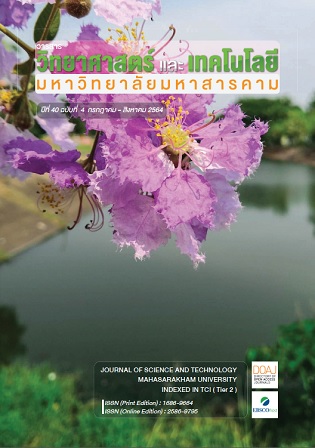The The Study of Suitable Environment for a Production of Bioactive Compounds (ß-glucan) Reducing the Risks of Gout Attacks in Oyster Mushroom Fruiting Body -
Main Article Content
Abstract
A study of suitable environment for enhancing yield quality of fruiting bodies and ß-glucan compound in Oyster mushroom for reducing the risks of gout attacks depends on many factors, such as the strain of mushroom, substrate and growth condition. According to this study were selected mushroom strain and optimized mycelium growth conditions including medium, pH, temperature under laboratory condition and substrates for 7 formulations in mushroom house condition. When harvesting and analyzing the nutritional value, mineral and ß-glucan content. The results indicate that GYE, pH 7 was a suitable medium for growing oyster mushroom at 25oC. The TISTR-Agr PPU 009 strain cultivated on formula 4 (sawdust mixed with rice straw) was produced the highest 55.17 mg/g of dry mushroom weight. Moreover, it has good quality and higher nutritional value than cultivation from other substrates.
Article Details
References
เติมพงศ์ แสงปกรณ์กิจ. เห็ดนางฟ้า. กรุงเทพฯ : สำนักพิมพ์เกษตรสยามบุ๊ค. 2552.
ทิพวรรณ สิทธิรังสรรค์. เกษตรธรรมชาติ. โอเดียนสโตร์ : กรุงเทพมหานคร. 2551.
ประดิภา ประดับไพร, วันณรงค์ เติมอารมณ์, ตันติมา กำลัง, ธนภักษ์ อินยอด. ผลของปริมาณธาตุอาหารและสภาพแวดล้อมต่อการเจริญเติบโตและการสร้างสารสำคัญ ของเห็ดตระกูลนางฟ้าในสภาพโรงเรือนเปิดดอก. วารสารเห็ดไทย, 12; กรกฎาคม-ธันวาคม, 2557.
Adebayo-Tato, B.C., Jonathan S.G., Popoola, O.O., & Egbomuche, R.C. (2011). Optimization of growth conditions for mycelial yield and exopolysaccharride production by Pleurotus ostreatus cultivated in Nigeria. Journal of Microbiology Research, 5(15), 2130-21385.
AOAC. 1995. Official methods of analysis of the Association of Official Analytical Chemists (16th ed.), Washington, DC: AOAC.
Bach, F., Helm, C.V., Bellettini, M.B., Maciel, G.M., & Haminiuk, C.W.I. (2011). Edible mushrooms: a potential source of essential amino acids,
glucans and minerals. International Journal of Food Science and Technology, 1-11. https://doi.org/10.1111/ijfs.13522.
Chen, X. (1998). Studies on mushroom recultivation on used compost waste. In: Proceedings of the 98’ Nanjing International Symposium on Science and Cultivation of Mushrooms. 12-15 October 1998. Nanjing, China, p. 56.
Erkel, E.L. (2009). The effect of different substrates medium on yield of Ganoderma lucidum (Fr.) Karst. Journal of Food Agriculture and Environment, 77(3), 841-844. DOI:10.3126/on.v10i1.7781.
Finimundy, T. C., Gambato, G., Fontana R., Camassola, M., Salvador, M., Moura, S., Hess, J., Henriques, J.A.P., Dillon, A.J.P., & Roesch-Ely M. (2013). Aqueous extracts of Lentinula edodes and Pleurotus sajor-caju exhibit high antioxidant capability and promising in vitro antitumor activity. Nutrition Research, 33(1), 76–84. DOI: 10.1016/j.nutres.2012.11.005.
Hansen, J. & Møller, I. (1975). Percolation of starch and soluble carbohydrates from plant tissue for quantitative determination with anthrone. Analytical Biochemistry, 68(1), 87-94. DOI: 10.1016/0003-2697(75)90682-x.
Hoa, H.T., & Wang, C.L. (2015). The Effects of Temperature and Nutritional Conditions on Mycelium Growth of Two Oyster Mushrooms (Pleurotus ostreatus and Pleurotus cystidiosus). Mycobiology, 43(1), 14-23. DOI: 10.5941/MYCO.2015.43.1.14.
Hsieh, C., Hsu, T.H., & Yang, F.C. (2005). Production of polysaccharides of Ganoderma lucidum (CCRC36021) by reusing thin stillage. Process biochemistry, 40(2), 909-916. DOI:10.1016/j.procbio.2004.02.004.
Jiang, M., Zhao, M.M., Zhou, ZW., Huang, T., Chen, XL., & Wang, Y. (2011). Isolation of cellulose with ionic liquid from steam exploded rice straw. Industrial Crops and Products, 33(3), 734-738. https://doi.org/10.1016/j.indcrop.2011.01.015.
Kim, D.H., Yang, B.K., Jeong, S.C., Park, J.B., Cho, S.P., Das, S., Yun, J.W., & Song, C.H. (2001). Production of a hypoglycemic, extracellular polysaccharide from the submerged culture of the mushroom, Phellinus linteus. Biotechnology Letters, 23, 513-7. DOI:10.1023/A:1010312513878.
Kjeldahl, J. (1883). Neue Methode zur Bestimmung des Stickstoffs in organischen. Körpern Z. Analytical Chemistry, 22, 366-382. https://doi.org/10.1007/BF01338151.
Kuforiji, O.O., & Fasidi, I.O. (2005). Factors affecting the yield of Volvariella volvacea in various agro-wastes. Nig. Journal Microbiology, 19, 550-555.
Kumla, J., Suwannarach, N., Jaiyasen, A., Bussaban B., & Lumyong, S. (2013). Development of an Edible Wild Strain of Thai Oyster Mushroom for Economic Mushroom Production. Chiang Mai Journal of Science, 40(2) : 161-172.
Kuo, C.F, Grainge, M.J., Zhang, W., & Doherty, M. (2015). Global epidemiology of gout: prevalence, incidence and risk factors. Nature Reviews Rheumatology, 11(11), 649-62. doi: 10.1038/nrrheum.2015.91.
Kupradit, C., Ranok, A., Mangkalanan, S., Khongla C., & Musika, S. (2020). Effects of Natural Carbon Sources and Temperature on Mycelium Cultivations of Lentinus squarrosulus (Mont.), Lentinus polychrous Lev., Pleurotus ostreatus (Jacq.ex Fr.) P. Kumm. and Volvariella volvacea (Bull.) Singer. Thai Journal of Science and Technology, 9(4), https://doi.org/10.14456/tjst.2020.57.
Lissandra, S.Q., Nascimento, M.S., Cruz,A.K.M., Castro, A.J.G., Moura, M.F.V., Baseia, I.G., Araújo, R.M., Benevides, N.M.B., Lima, L.F.A., & Leite, E.L. (2010). Glucans from the Caripia montagnei mushroom present anti-inflammatory activity. International Immunopharmacology, 10, 34-42. https://doi.org/10.1016/j.intimp.2009.09.015.
Ragab, G., Elshahaly, M., & Bardin, T. (2017). Gout: An old disease in new perspective – A review. Journal of Advanced Research, 8(5), 495–511. doi: 10.1016/j.jare.2017.04.008.
Rambey, R., Sitepu, I.D.B., & Siregar, E.B.M. (2019). Productivity of oyster mushrooms (Pleurotus ostreatus) on media corncobs mixed with sawdust. Earth and Environmental Science, 260, 1-6. doi:10.1088/1755-1315/260/1/012076.
Westerman, R.L. (1990). Soil testing and plant analysis, 3rd ed. Madison, WI: Soil Science Society of America, 512.
Willard, H.H., Merrill, L.L., & Dean, J.A. (2001). Laboratory Work Instrumental Methods of Analysis, New York, 405.
Yoshioka, Y,. Tabeta, R., Saitô, H., Uehara, N., & Fukuoka F. (1985). Antitumor polysaccharides from P. ostreatus (Fr.) quél.: Isolation and structure of a -glucan. Carbohydrate Research, 140(1), 93-100. doi: 10.1016/0008-6215(85)85052-7.


